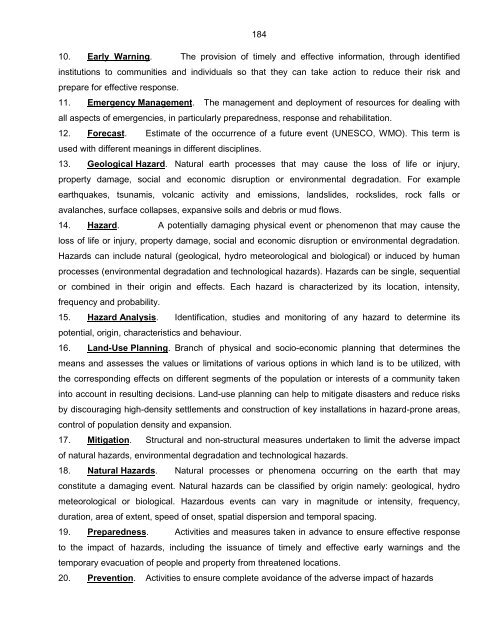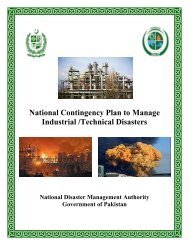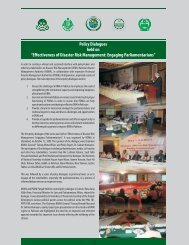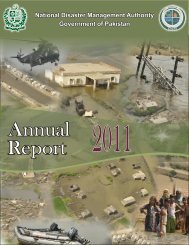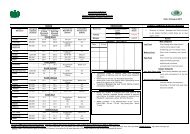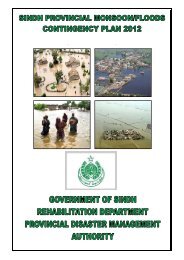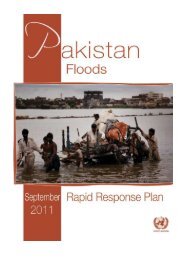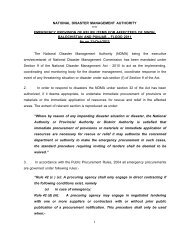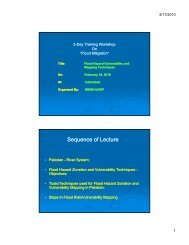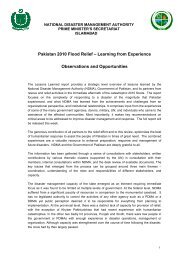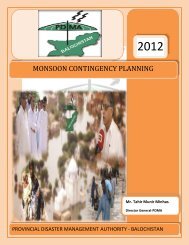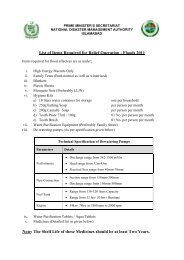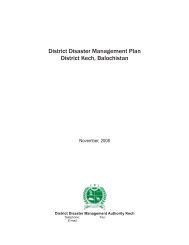National Disaster Response Plan (NDRP) March 2010 - NDMA
National Disaster Response Plan (NDRP) March 2010 - NDMA
National Disaster Response Plan (NDRP) March 2010 - NDMA
You also want an ePaper? Increase the reach of your titles
YUMPU automatically turns print PDFs into web optimized ePapers that Google loves.
184<br />
10. Early Warning. The provision of timely and effective information, through identified<br />
institutions to communities and individuals so that they can take action to reduce their risk and<br />
prepare for effective response.<br />
11. Emergency Management. The management and deployment of resources for dealing with<br />
all aspects of emergencies, in particularly preparedness, response and rehabilitation.<br />
12. Forecast. Estimate of the occurrence of a future event (UNESCO, WMO). This term is<br />
used with different meanings in different disciplines.<br />
13. Geological Hazard. Natural earth processes that may cause the loss of life or injury,<br />
property damage, social and economic disruption or environmental degradation. For example<br />
earthquakes, tsunamis, volcanic activity and emissions, landslides, rockslides, rock falls or<br />
avalanches, surface collapses, expansive soils and debris or mud flows.<br />
14. Hazard. A potentially damaging physical event or phenomenon that may cause the<br />
loss of life or injury, property damage, social and economic disruption or environmental degradation.<br />
Hazards can include natural (geological, hydro meteorological and biological) or induced by human<br />
processes (environmental degradation and technological hazards). Hazards can be single, sequential<br />
or combined in their origin and effects. Each hazard is characterized by its location, intensity,<br />
frequency and probability.<br />
15. Hazard Analysis. Identification, studies and monitoring of any hazard to determine its<br />
potential, origin, characteristics and behaviour.<br />
16. Land-Use <strong>Plan</strong>ning. Branch of physical and socio-economic planning that determines the<br />
means and assesses the values or limitations of various options in which land is to be utilized, with<br />
the corresponding effects on different segments of the population or interests of a community taken<br />
into account in resulting decisions. Land-use planning can help to mitigate disasters and reduce risks<br />
by discouraging high-density settlements and construction of key installations in hazard-prone areas,<br />
control of population density and expansion.<br />
17. Mitigation. Structural and non-structural measures undertaken to limit the adverse impact<br />
of natural hazards, environmental degradation and technological hazards.<br />
18. Natural Hazards. Natural processes or phenomena occurring on the earth that may<br />
constitute a damaging event. Natural hazards can be classified by origin namely: geological, hydro<br />
meteorological or biological. Hazardous events can vary in magnitude or intensity, frequency,<br />
duration, area of extent, speed of onset, spatial dispersion and temporal spacing.<br />
19. Preparedness. Activities and measures taken in advance to ensure effective response<br />
to the impact of hazards, including the issuance of timely and effective early warnings and the<br />
temporary evacuation of people and property from threatened locations.<br />
20. Prevention. Activities to ensure complete avoidance of the adverse impact of hazards


